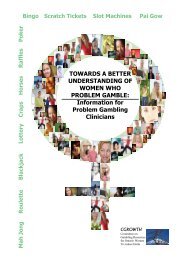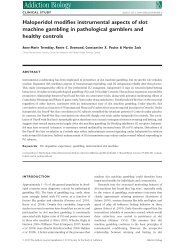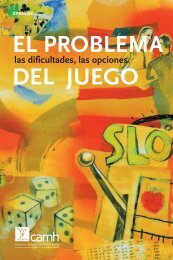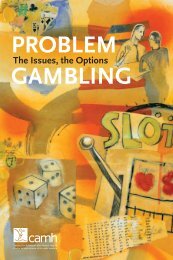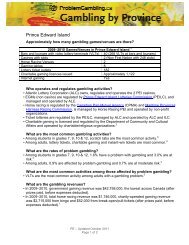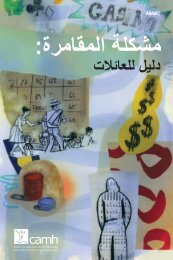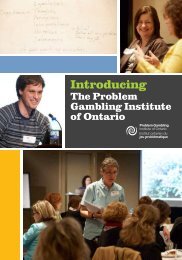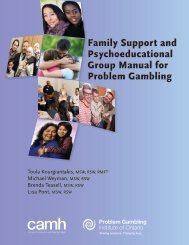Probability, Random Events, and the Mathematics of Gambling
Probability, Random Events, and the Mathematics of Gambling
Probability, Random Events, and the Mathematics of Gambling
You also want an ePaper? Increase the reach of your titles
YUMPU automatically turns print PDFs into web optimized ePapers that Google loves.
a million flips extra tails would have to have occurred for <strong>the</strong> measured average to be close to<br />
50%. One individual argued that <strong>the</strong>re had to be a “bias” in favor <strong>of</strong> tails to get <strong>the</strong> average<br />
back to 50%. This is still incorrect. According to <strong>the</strong> law <strong>of</strong> large numbers, it is not <strong>the</strong> actual<br />
number <strong>of</strong> flips that converges to <strong>the</strong> probability percentage, but <strong>the</strong> average number <strong>of</strong> flips.<br />
Suppose we start by getting 10 heads in a row <strong>and</strong> keep flipping <strong>the</strong> coin 1 million times.<br />
Does <strong>the</strong> difference <strong>of</strong> 10 go away? No. In fact, after 1 million flips <strong>the</strong> number <strong>of</strong> heads <strong>and</strong><br />
tails could differ by as much as 1 or 2 thous<strong>and</strong>. Even a difference <strong>of</strong> 9,000 more tails than<br />
heads would still round <strong>of</strong>f to 50% after one million flips. Consequently, <strong>the</strong> individual<br />
cannot use deviations from <strong>the</strong> expected average to get an edge.<br />
It is important to realize that this “law” is really only a statement that summarizes what has<br />
been observed, most <strong>of</strong> <strong>the</strong> time, over a large (in <strong>the</strong>ory, infinite) number <strong>of</strong> events. It says<br />
absolutely nothing about what will happen next or is likely to happen. Suppose a coin was<br />
tossed <strong>and</strong> <strong>the</strong> first 10 coin tosses resulted in <strong>the</strong> following sequence <strong>of</strong> heads <strong>and</strong> tails: T, H,<br />
H, H, H, H, T, H, H, H (20% tails, 80% heads). If <strong>the</strong> next 40 trials resulted in 19 tails <strong>and</strong> 21<br />
heads (47.5% tails <strong>and</strong> 52.5% heads), <strong>the</strong> cumulative percentage <strong>of</strong> tails after all 50 trials<br />
would have moved from 20% to 42%—even though more heads came up during <strong>the</strong><br />
subsequent flips. Incidentally, a player who bet $1 on tails on each <strong>of</strong> <strong>the</strong> 40 trials, assuming<br />
that tails was “due,” would have ended up losing $2. The average converges toward <strong>the</strong><br />
expected mean, but it does not correct itself.<br />
This can be illustrated by comparing Figures 1 <strong>and</strong> 2. Figure 1 shows <strong>the</strong> percentage <strong>of</strong> heads<br />
<strong>and</strong> tails in numerous coin tossing trials, while Figure 2 shows <strong>the</strong> actual number <strong>of</strong> heads <strong>and</strong><br />
tails. In Figure 1, it is clear that <strong>the</strong> ratio <strong>of</strong> heads to tails is converging to <strong>the</strong> average <strong>of</strong> 50%<br />
as <strong>the</strong> number <strong>of</strong> tosses increases. Figure 2, however, shows that <strong>the</strong> actual number <strong>of</strong> heads<br />
<strong>and</strong> tails is not converging. In fact, as <strong>the</strong> number <strong>of</strong> tosses increases, <strong>the</strong> line depicting <strong>the</strong><br />
balance <strong>of</strong> heads vs. tails drifts away from 0. In some cases, <strong>the</strong> line drifts up (more heads)<br />
<strong>and</strong> in some case it drifts down (more tails). Many people who gamble underst<strong>and</strong> <strong>the</strong> idea<br />
that <strong>the</strong> average converges towards <strong>the</strong> mean (Figure 1), but mistakenly believe that <strong>the</strong> actual<br />
number <strong>of</strong> heads <strong>and</strong> tails also converges towards <strong>the</strong> mean. The thick line in both graphs<br />
represents an individual coin that started out with more heads than tails. Notice how even<br />
though its average converges towards 50% (Figure 1), <strong>the</strong> line depicting <strong>the</strong> balance <strong>of</strong> heads<br />
<strong>and</strong> tails continues to drift upwards away from <strong>the</strong> mean (Figure 2).<br />
10







